CEL 27 (2011) - Up-dated Adult Exceptional Aesthetic ... - 18 Weeks
CEL 27 (2011) - Up-dated Adult Exceptional Aesthetic ... - 18 Weeks
CEL 27 (2011) - Up-dated Adult Exceptional Aesthetic ... - 18 Weeks
- No tags were found...
You also want an ePaper? Increase the reach of your titles
YUMPU automatically turns print PDFs into web optimized ePapers that Google loves.
The <strong>Adult</strong> <strong>Exceptional</strong> <strong>Aesthetic</strong> Referral Protocol (AEARP)September <strong>2011</strong><strong>Aesthetic</strong> surgery is not routinely offered by the NHS and can only be providedon an exceptional case basis in line with the guidelines contained in this protocol.Please Note• Patients should only be referred following a clinical assessment where there is asymptomatic or functional requirement for surgery.• All cases will be judged against agreed criteria on an individual basis.• Referral for consideration does not necessarily mean that surgery will beoffered. This must be communicated to the patient.
The <strong>Adult</strong> <strong>Exceptional</strong> <strong>Aesthetic</strong> Referral Protocol (AEARP)September <strong>2011</strong>Referrer must first assess the following before taking the decision to make a referral under the AEARP.Patient’s Age If patient is younger than 16 years of age. AEARP is not applicable. The patient shouldbe managed according to clinical need.Body Mass Index (BMI)Impairment of FunctionPsychological DistressBMI is a pre-requisite for a number of the procedures coveredby the protocol.Where there is a significant functional impairment which canbe improved by surgery.Referral under the protocol may be indicated where thepatient has significant and prolonged psychological distressand associated impairment in functioning related to theperceived problem and likely to benefit from aesthetic surgery.Check the specific assessment criteriaunder the protocol.AEARP may not be applicable. Makea referral to a specialty appropriate tosymptoms but check relevant sectionwithin this document for details.Check the specific assessment criteria underthe protocol. Psychology assessment mustbe by the specialist Clinical Psychologistsworking with a regional centre.ContraindicationsSignificant Major Life EventIf a patient has had a major life event in the previous 12months e.g. birth, relationship breakdown or a significantbereavement.<strong>Aesthetic</strong> Surgery is contra indicated.Consider Significant Major Life Eventdeferring referral until recovery.Referral for aesthetic surgery is contra indicated where:• a patient has had an episode of self harm within the last two years;• there is a previous diagnosis of body dysmorphic disorder;• the patient has a disproportionate view of the problem following your examination;• the patient currently has:° ° a major depressive illness;° ° an active delusional or schizophrenic illness;° ° an eating disorder;° ° obsessive compulsive disorder;° ° substance abuse problem.
The <strong>Adult</strong> <strong>Exceptional</strong> <strong>Aesthetic</strong> Referral Protocol (AEARP)September <strong>2011</strong>TreatmentBody ContouringBenign Skin LesionBlepharroplastyBreast SurgeryBreast AugmentationMastopexyBreast ReductionBreast Implant ComplicationsGynaecomastiaInverted Nipple Correction<strong>Aesthetic</strong> Facial SurgeryHair TransplantationPinnaplastyRhinoplastyTattoo RemovalThread VeinsGenital Surgery for Functional Indications
The <strong>Adult</strong> <strong>Exceptional</strong> <strong>Aesthetic</strong> Referral Protocol (AEARP)September <strong>2011</strong>BlepharroplastyProcedures not routinely provided by the NHS<strong>Up</strong>per and Lower blepharroplasty—surgery for removal of excess skin and/or ‘eye-bags’.Clinical PsychologyReferral to a specialist Clinical Psychologist may be made at the discretion of the surgical team.BMIThere are no specific BMI restrictions.If BMI significantly raised consider carefully whether patient is appropriate for this type of surgery.Special ConsiderationsInclusionsSurgery may be considered where there is restriction of the visual field by the excess skin. Visual field tests to be carried out prior to referral.ExclusionsSurgery will not be considered where a perception of tiredness or ageing is the primary concern.Waiting TimesBlepharroplasty for restricted visual fields is subject to <strong>18</strong> <strong>Weeks</strong> Referral to Treatment Standard.<strong>Aesthetic</strong> surgery is not routinely offered by the NHS and can only be provided on an exceptional case basis in line with theguidelines contained in this protocol.Return to Index Last <strong>Up</strong><strong>dated</strong>: 28 September <strong>2011</strong>
The <strong>Adult</strong> <strong>Exceptional</strong> <strong>Aesthetic</strong> Referral Protocol (AEARP)September <strong>2011</strong>Breast SurgeryProcedures not routinely provided by the NHSAll procedures to change the appearance of the breast in size, shape or position.Patients undergoing surgery for breast cancer should be considered under the appropriate pathway.Clinical PsychologyAll referrals will be seen by a specialist Clinical Psychologist prior to assessment by a surgeon.Patients undergoing reconstructive surgery may not require psychological assessment. This decision will be at the discretion of the surgical team.BMI> 20 and ≤<strong>27</strong>.BMI ≤ 33 may be considered in patients undergoing a planned programme of reconstructive breast surgery.Special ConsiderationsSpecific to individual procedures, see ‘specific procedures’ list below for links to relevant sections.Patients with asymmetry may require one or more of procedures described below.Photography can be invaluable in assessing referrals. Please include photographs where possible.Surgery to reverse the normal ageing or post-involutional changes will not be supported.Specific ProceduresBreast AugmentationMastopexyBreast ReductionBreast Implant ComplicationsGynaecomastiaInverted Nipple Correction<strong>Aesthetic</strong> surgery is not routinely offered by the NHS and can only be provided on an exceptional case basis in line with theguidelines contained in this protocol.Return to Index Last <strong>Up</strong><strong>dated</strong>: 28 September <strong>2011</strong>
The <strong>Adult</strong> <strong>Exceptional</strong> <strong>Aesthetic</strong> Referral Protocol (AEARP)September <strong>2011</strong>Breast AugmentationProcedures not routinely provided by the NHSBreast Augmentation using implants or other techniques e.g. fat transfer.Clinical PsychologyAll referrals will be seen by a specialist Clinical Psychologist prior to assessment by a surgeon.Patients undergoing reconstructive surgery may not require psychological assessment. This decision will be at the discretion of the surgical team.BMI>20 -≤<strong>27</strong>.BMI ≤ 33 may be considered in patients undergoing a planned programme of reconstructive surgery.Special ConsiderationsInclusionsSignificant psychological distress combined with physical symptoms (as confirmed by a specialist Clinical Psychologist).Congenital asymmetry > 1 cup size.Congenital aplasia/hypoplasia (inc tuberous breast).Congenital chest wall deformity (e.g. Poland’s Syndrome).Implant surgery may be appropriate for asymmetry following breast cancer treatment.ExclusionsSimple cosmetic augmentation.Surgery to reverse the normal ageing or post-involutional changes will not be supported.Waiting TimesThese patients are not subject to the <strong>18</strong> <strong>Weeks</strong> Referral to Treatment Standard.Some patients may be subject to guarantee times within other pathways.<strong>Aesthetic</strong> surgery is not routinely offered by the NHS and can only be provided on an exceptional case basis in line with theguidelines contained in this protocol.Return to breast surgeryReturn to Index Last <strong>Up</strong><strong>dated</strong>: 28 September <strong>2011</strong>
The <strong>Adult</strong> <strong>Exceptional</strong> <strong>Aesthetic</strong> Referral Protocol (AEARP)September <strong>2011</strong>MastopexyProcedures not routinely provided by the NHSSurgery performed primarily for breast uplift (with small elements of reduction).Clinical PsychologyAll referrals will be seen by a specialist Clinical Psychologist prior to assessment by a surgeon.Patients undergoing reconstructive surgery may not require psychological assessment. This decision will be at the discretion of the surgical team.BMI>20–≤<strong>27</strong>.BMI ≤ 33 may be considered in patients undergoing a planned programme of reconstructive surgery.Special ConsiderationsInclusionsCongenital asymmetry > 1 cup size.Congenital aplasia/hypoplasia.Chest wall deformity e.g. Poland’s Syndrome.Asymmetry following Breast Cancer treatment.ExclusionsSimple cosmetic uplift.Surgery to reverse the normal ageing or post-involutional changes will not be supported.Waiting TimesThese patients are not subject to the <strong>18</strong> <strong>Weeks</strong> Referral to Treatment Standard.Some patients may be subject to guarantee times within other pathways.<strong>Aesthetic</strong> surgery is not routinely offered by the NHS and can only be provided on an exceptional case basis in line with theguidelines contained in this protocol.Return to breast surgeryReturn to Index Last <strong>Up</strong><strong>dated</strong>: 28 September <strong>2011</strong>
The <strong>Adult</strong> <strong>Exceptional</strong> <strong>Aesthetic</strong> Referral Protocol (AEARP)September <strong>2011</strong>Breast ReductionProcedures not routinely provided by the NHSSurgery to reduce breast sizeClinical PsychologyAll referrals will be seen by a specialist Clinical Psychologist prior to assessment by a surgeon.Patients undergoing reconstructive surgery may not require psychological assessment. This decision will be at the discretion of the surgical team.BMI>20–≤<strong>27</strong>.BMI ≤ 33 may be considered in patients undergoing a planned programme of reconstructive surgery.Special ConsiderationsInclusionsMassive disproportion to body habitus.Intractable intertrigo.Asymmetry > 1 cup size.Breast reduction may be appropriate for asymmetry following breast cancer treatment.ExclusionsSimple cosmetic reduction.Breast reduction is not a useful primary treatment for breast, back, neck or shoulder pain.Surgery to reverse the normal ageing or post-involutional changes will not be supported.Generally inadvisable in patients < <strong>18</strong> years old.Waiting TimesThese patients are not subject to the <strong>18</strong> <strong>Weeks</strong> Referral to Treatment Standard.Some patients may be subject to guarantee times within other pathways.<strong>Aesthetic</strong> surgery is not routinely offered by the NHS and can only be provided on an exceptional case basis in line with theguidelines contained in this protocol.Return to breast surgeryReturn to Index Last <strong>Up</strong><strong>dated</strong>: 28 September <strong>2011</strong>
The <strong>Adult</strong> <strong>Exceptional</strong> <strong>Aesthetic</strong> Referral Protocol (AEARP)September <strong>2011</strong>Breast Implant ComplicationsProcedures not routinely provided by the NHSSurgery to correct change in the appearance, size or shape of a breast with a prior history of implant surgery.Replacement of breast implants will only be performed where the original implant surgery was performed by the NHS.Patients who have had implant surgery performed privately for reconstruction after breast cancer will be treated as if their implants have been provided by theNHS.Patients who have had implant surgery performed for cosmetic reasons and present with implant related complications should initially be referred back to theorganisation which performed their surgery.Where this is not possible, investigation and treatment up to the removal of the implant may be performed.Clinical PsychologyReferral to a specialist Clinical Psychologist may be made at the discretion of the surgical team.BMIThere are no specific BMI restrictions.If BMI significantly raised consider carefully whether patient is appropriate for this type of surgery.Special ConsiderationsInclusionsChange in the appearance, size or shape of a breast with a prior history of implant surgery.Pain related to capsular contracture.ExclusionsImplants placed privately for cosmetic reasons will not be replaced by NHSScotland. This would establish an ongoing duty of care for the replacement implants.Waiting TimesThese patients are subject to the <strong>18</strong> <strong>Weeks</strong> Referral to Treatment Standard.Patients do not require routine follow-up.<strong>Aesthetic</strong> surgery is not routinely offered by the NHS and can only be provided on an exceptional case basis in line with theguidelines contained in this protocol.Return to breast surgeryReturn to Index Last <strong>Up</strong><strong>dated</strong>: 28 September <strong>2011</strong>
The <strong>Adult</strong> <strong>Exceptional</strong> <strong>Aesthetic</strong> Referral Protocol (AEARP)September <strong>2011</strong>GynaecomastiaProcedures not routinely provided by the NHSSurgery to change the shape/volume of the male breast.May include subcutaneous mastectomy or liposuction.Clinical PsychologyAll referrals will be seen by specialist Clinical Psychologist prior to an assessment by a surgeon.BMI> 20 ≤<strong>27</strong>.Special ConsiderationsScreening for hormone levels should be done prior to referral.Where indicated referral to Endocrinology should precede referral for surgery.InclusionsClinically significant breast prominence.Feminised nipple areola complex.Significant breast asymmetry.Significant psychological distress.ExclusionsWhere clinical appearance does not match patient perception.Waiting TimesThese patients are not subject to the <strong>18</strong> <strong>Weeks</strong> Referral to Treatment Standard.<strong>Aesthetic</strong> surgery is not routinely offered by the NHS and can only be provided on an exceptional case basis in line with theguidelines contained in this protocol.Return to breast surgeryReturn to Index Last <strong>Up</strong><strong>dated</strong>: 28 September <strong>2011</strong>
The <strong>Adult</strong> <strong>Exceptional</strong> <strong>Aesthetic</strong> Referral Protocol (AEARP)September <strong>2011</strong>Inverted Nipple CorrectionProcedures not routinely provided by the NHSSurgery to correct inversion of a congenital nipple.Acquired nipple inversion may be a sign of serious underlying disease and must be investigated and referred via the appropriate protocol.Clinical PsychologyReferral to a specialist Clinical Psychologist may be made at the discretion of the surgical team, following use of a nipple device for a period of 6 months.BMIThere are no specific BMI restrictions.If BMI significantly raised consider carefully whether patient is appropriate for this type of surgery.Special ConsiderationsAcquired nipple inversion may be a sign of serious underlying disease and initial referral should be directed to a general surgical breast clinic.In the absence of significant disease conservative treatment with proprietary suction devices for at least six months should be tried prior to considering referral.Patients should be made aware prior to referral that surgical correction is likely to render subsequent breast feeding impossible.InclusionsNipple inversion not responsive to conservative treatment in the absence of significant breast pathology.ExclusionsPatients not compliant with conservative measures.Waiting TimesThese patients are not subject to the <strong>18</strong> <strong>Weeks</strong> Referral to Treatment Standard.Referrals for suspicion of malignancy should be made via the appropriate cancer pathway.<strong>Aesthetic</strong> surgery is not routinely offered by the NHS and can only be provided on an exceptional case basis in line with theguidelines contained in this protocol.Return to breast surgeryReturn to Index Last <strong>Up</strong><strong>dated</strong>: 28 September <strong>2011</strong>
The <strong>Adult</strong> <strong>Exceptional</strong> <strong>Aesthetic</strong> Referral Protocol (AEARP)September <strong>2011</strong><strong>Aesthetic</strong> Facial SurgeryProcedures not routinely provided by the NHSSurgery for lifting one or both sides of the neck, face and brow.May include all types facelift, brow lift, neck lift.Indications may include patients with collagen diseases (e.g. cutis laxa) or facial palsy.Clinical psychologyAll referrals for simple age related changes with no underlying cause will be returned.Referral to a specialist Clinical Psychologist may be made at the discretion of the surgical team.BMIThere are no specific BMI restrictions.If BMI significantly raised consider carefully whether patient is appropriate for this type of surgery.Special ConsiderationsInclusionsWhere there is a specific, relevant underlying cause, please make this clear in any referral.Referrals for brow lift may be considered where there is a demonstrable visual field defect. Visual field tests to be carried out prior to referral.ExclusionsSurgery simply to reverse the normal ageing process will not be supported.Waiting timesThese patients are not subject to the <strong>18</strong> <strong>Weeks</strong> Referral to Treatment however brow lift for restricted visual fields is subject to the <strong>18</strong> weeks Referral to TreatmentStandard.<strong>Aesthetic</strong> surgery is not routinely offered by the NHS and can only be provided on an exceptional case basis in line with theguidelines contained in this protocol.Return to Index Last <strong>Up</strong><strong>dated</strong>: 28 September <strong>2011</strong>
The <strong>Adult</strong> <strong>Exceptional</strong> <strong>Aesthetic</strong> Referral Protocol (AEARP)September <strong>2011</strong>Hair TransplantationProcedures not usually provided by the NHSGrafting or other techniques to restore hair growth to an area of alopecia.Clinical PsychologyReferral to specialist Clinical Psychologist may be made at the discretion of the surgical team.BMIThere are no specific BMI restrictions.If BMI significantly raised consider carefully whether patient is appropriate for this type of surgery.Special ConsiderationsInclusionsFollowing trauma (including surgery), burns, or rare congenital conditions.ExclusionsReferrals for normal male pattern baldness will not be considered.Waiting TimesThese patients are not subject to the <strong>18</strong> <strong>Weeks</strong> Referral to Treatment Standard.<strong>Aesthetic</strong> surgery is not routinely offered by the NHS and can only be provided on an exceptional case basis in line with theguidelines contained in this protocol.Return to Index Last <strong>Up</strong><strong>dated</strong>: 28 September <strong>2011</strong>
The <strong>Adult</strong> <strong>Exceptional</strong> <strong>Aesthetic</strong> Referral Protocol (AEARP)September <strong>2011</strong>PinnaplastyProcedures not usually provided by the NHSSurgery to alter the form of the external ear.Clinical PsychologyAll referrals will be seen by a specialist Clinical Psychologist prior to assessment by a surgeon.BMIThere are no specific BMI restrictions.If BMI significantly raised consider carefully whether patient is appropriate for this type of surgery.Special ConsiderationsInclusionsThere should be clinically evident significant prominence of the ear(s) and this should be made clear in the referral.Congenital anomalies will usually have been dealt with in childhood, before the onset of this protocol.ExclusionsSimple cosmetic pinnaplasty will not be supported.Waiting TimesThese patients are not subject to the <strong>18</strong> <strong>Weeks</strong> Referral to Treatment Standard.<strong>Aesthetic</strong> surgery is not routinely offered by the NHS and can only be provided on an exceptional case basis in line with theguidelines contained in this protocol.Return to Index Last <strong>Up</strong><strong>dated</strong>: 28 September <strong>2011</strong>
The <strong>Adult</strong> <strong>Exceptional</strong> <strong>Aesthetic</strong> Referral Protocol (AEARP)September <strong>2011</strong>RhinoplastyProcedures not usually provided by the NHSAll procedures to alter the form and appearance of the nose.May include procedures for nasal obstruction.Clinical PsychologyAll referrals where alteration of the form and appearance of the nose is the primary aim will be seen by specialist Clinical Psychologist.Referrals for nasal obstruction with alteration of the external appearance of the nose will be seen by Clinical Psychology.Referrals only for nasal obstruction do not require initial specialist Clinical Psychology assessment.Post-trauma referrals do not need specialist Clinical Psychology assessment if within one year of injury.Congenital anomalies (e.g. nasal deformity associated with cleft lip) will usually be in a continuing programme of treatment and are not subject to AEARP.BMIThere are no specific BMI restrictions.If BMI significantly raised consider carefully whether patient is appropriate for this type of surgery.Special ConsiderationsAs a general principle, any procedure performed purely for nasal obstruction does not require psychology assessment and is subject to <strong>18</strong> <strong>Weeks</strong> Referral toTreatment Standard.Other procedures will require psychology assessment and will not be subject to <strong>18</strong> <strong>Weeks</strong> Referral to Treatment Standard.InclusionsProcedures to alter the appearance of the nose after trauma within one year will usually be supported.After one year, post trauma specialist clinical psychology assessment is required.ExclusionsProcedures performed only for nasal obstruction fall outside this protocol.Simple cosmetic rhinoplasty will not be supported.Waiting TimesProcedures for nasal obstruction are subject to the <strong>18</strong> <strong>Weeks</strong> Referral to Treatment Standard.Procedures for nasal trauma within 12 months of injury fall are subject to the <strong>18</strong> <strong>Weeks</strong> Referral to Treatment Standard.All other indications for rhinoplasty are not subject to the <strong>18</strong> <strong>Weeks</strong> Referral to Treatment Standard.<strong>Aesthetic</strong> surgery is not routinely offered by the NHS and can only be provided on an exceptional case basis in line with theguidelines contained in this protocol.Return to Index Last <strong>Up</strong><strong>dated</strong>: 28 September <strong>2011</strong>
The <strong>Adult</strong> <strong>Exceptional</strong> <strong>Aesthetic</strong> Referral Protocol (AEARP)September <strong>2011</strong>Tattoo RemovalProcedures not usually provided by the NHSAny procedure (surgical or laser) for the purpose of removing or reducing a tattoo.Clinical PsychologyReferral to a specialist Clinical Psychologist will be at the discretion of the surgical team.BMIThere are no specific BMI restrictions.If BMI significantly raised consider carefully whether patient is appropriate for this type of surgery.Special ConsiderationsProfessional tattoos are usually incompletely removed by laser treatment.Treatment for post traumatic tattooing will be supported.Tattoo removal is not usually supported unless the tattoo was gained in the absence of consent.Tattoo removal other than of face, neck or hands is most unlikely to be supported.Waiting TimesThese patients are not subject to the <strong>18</strong> <strong>Weeks</strong> Referral to Treatment Standard.<strong>Aesthetic</strong> surgery is not routinely offered by the NHS and can only be provided on an exceptional case basis in line with theguidelines contained in this protocol.Return to Index Last <strong>Up</strong><strong>dated</strong>: 28 September <strong>2011</strong>
The <strong>Adult</strong> <strong>Exceptional</strong> <strong>Aesthetic</strong> Referral Protocol (AEARP)September <strong>2011</strong>Thread VeinsProcedures not usually provided by the NHSLaser and microsclerotherapy.Clinical PsychologyReferral to a specialist Clinical Psychologist will be may at the discretion of the surgical team.BMIThere are no specific BMI restrictions.If BMI significantly raised consider carefully whether patient is appropriate for this type of surgery.Special ConsiderationsTreatment is only supported for severe thread veins on the face.Photographs accompanying referrals are invaluable.Waiting TimesThese patients are not subject to the <strong>18</strong> <strong>Weeks</strong> Referral to Treatment Standard.<strong>Aesthetic</strong> surgery is not routinely offered by the NHS and can only be provided on an exceptional case basis in line with theguidelines contained in this protocol.Return to Index Last <strong>Up</strong><strong>dated</strong>: 28 September <strong>2011</strong>
The <strong>Adult</strong> <strong>Exceptional</strong> <strong>Aesthetic</strong> Referral Protocol (AEARP)September <strong>2011</strong>Genital Surgery for Functional IndicationsProcedures not routinely provided by the NHSProcedures performed to alter the appearance of the external genitalia.In the presence of physical dysfunction referral should be made to Gynaecology.In the presence of psychological/psychosexual dysfunction non-surgical treatment may be more appropriate.Clinical PsychologyAll referrals will be seen by a specialist Clinical Psychologist prior to assessment by a surgeon.BMI>20–≤<strong>27</strong>.Special ConsiderationsInclusionFunctional impairment which must be confirmed by an appropriate specialist. This must be a tertiary referral.ExclusionCosmetic genital surgery is not supported by NHSScotland.Waiting TimesThese patients are not subject to the <strong>18</strong> <strong>Weeks</strong> Referral to Treatment Standard.<strong>Aesthetic</strong> surgery is not routinely offered by the NHS and can only be provided on an exceptional case basis in line with theguidelines contained in this protocol.Return to Index Last <strong>Up</strong><strong>dated</strong>: 28 September <strong>2011</strong>


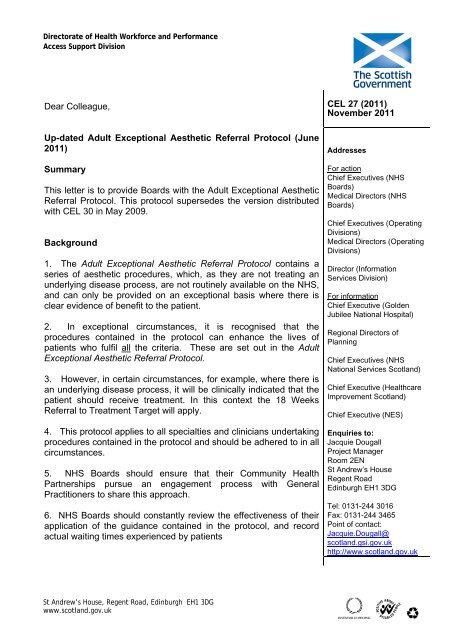
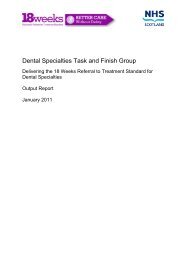
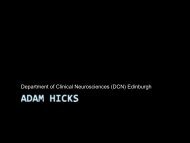
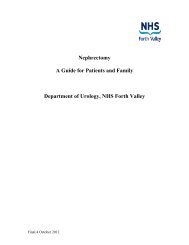
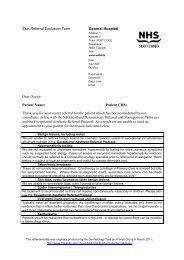
![Dr Matthew Checketts, NHS Tayside [PDF - 6Mb] - 18 Weeks](https://img.yumpu.com/49027155/1/190x143/dr-matthew-checketts-nhs-tayside-pdf-6mb-18-weeks.jpg?quality=85)
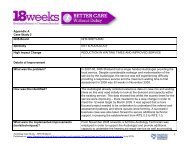
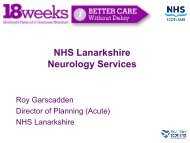
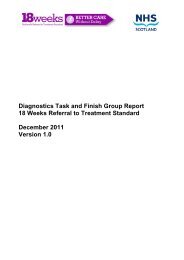
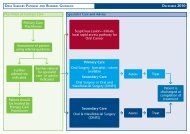


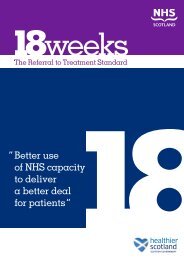

![Mark Sindall, NHS Dumfries and Galloway [PDF - 227Kb] - 18 Weeks](https://img.yumpu.com/30080335/1/190x143/mark-sindall-nhs-dumfries-and-galloway-pdf-227kb-18-weeks.jpg?quality=85)